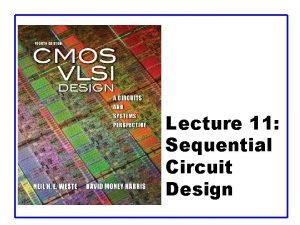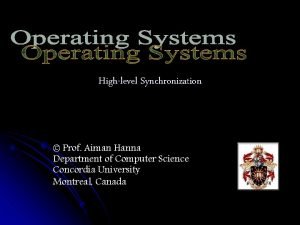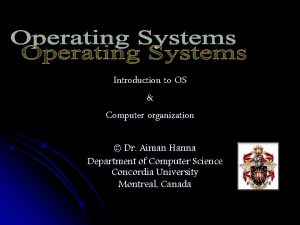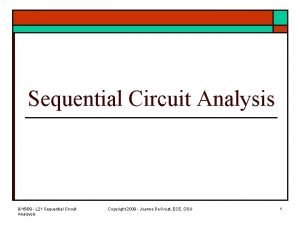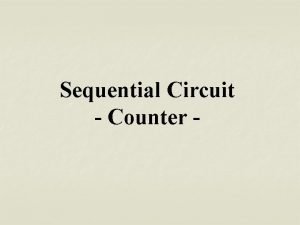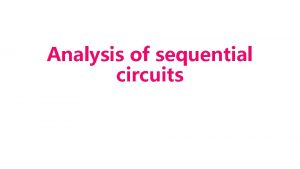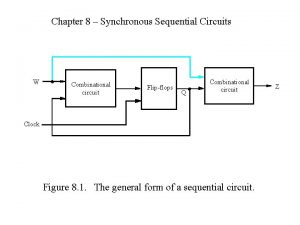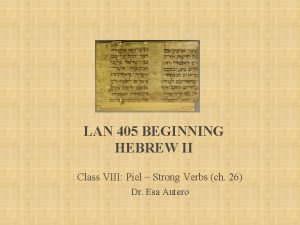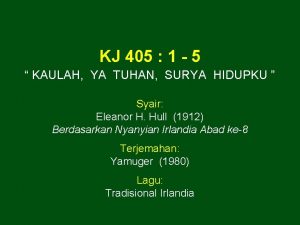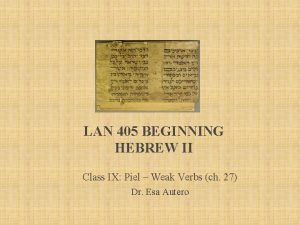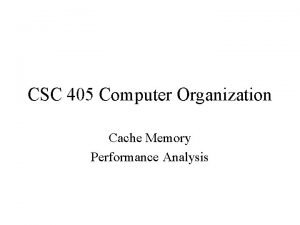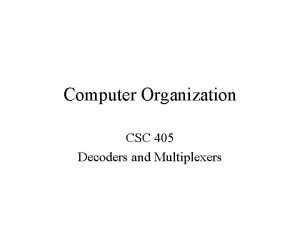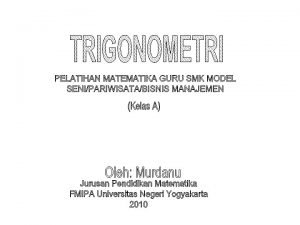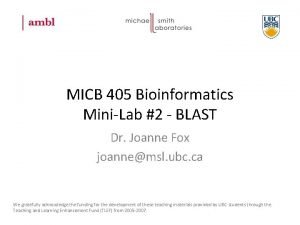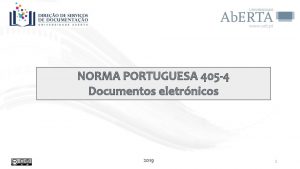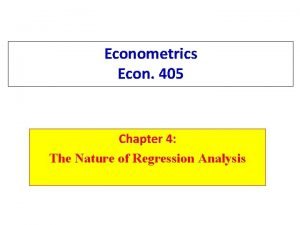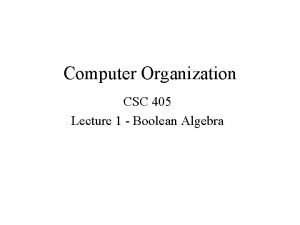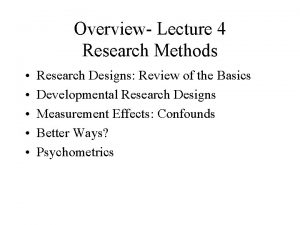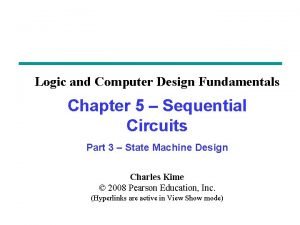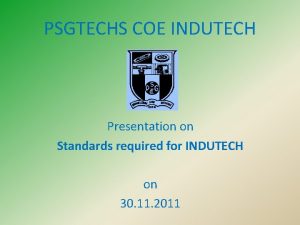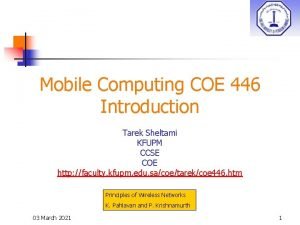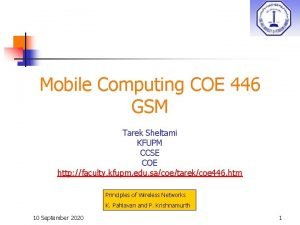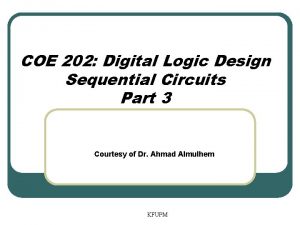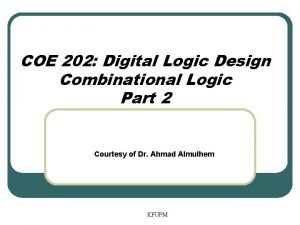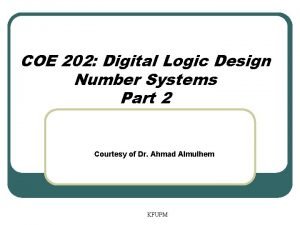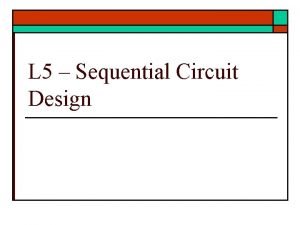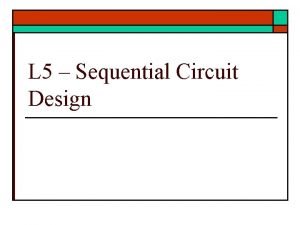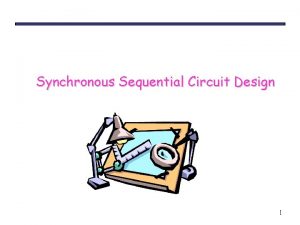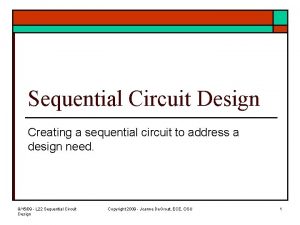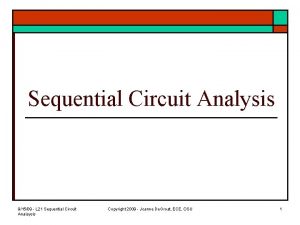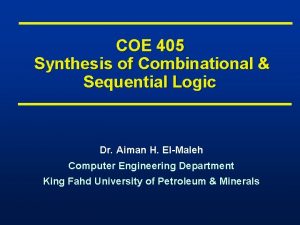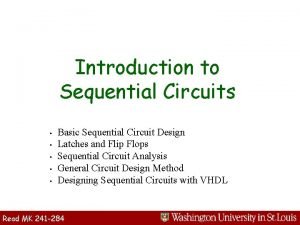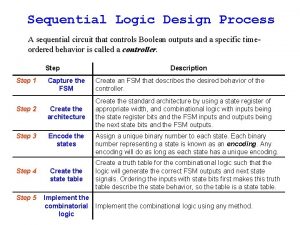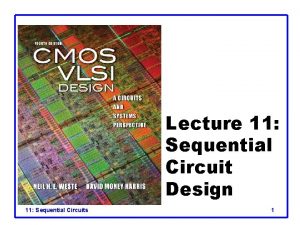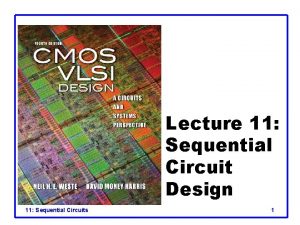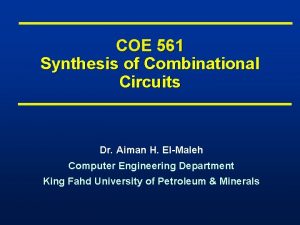COE 405 Sequential Circuit Design Dr Aiman H





















































- Slides: 53

COE 405 Sequential Circuit Design Dr. Aiman H. El-Maleh Computer Engineering Department King Fahd University of Petroleum & Minerals

Outline n Sequential Circuit Model n Timing of Sequential Circuits n Latches and Flip flops n Sequential Circuit Design Procedure n Sequential Circuit Design Examples n State Minimization n State Encoding n Sequential Circuit Timing 1 -2

Sequential Circuit Model n A Sequential circuit consists of: • Data Storage elements: (Latches / Flip-Flops) • Combinatorial Logic: • • • Implements a multiple-output function Inputs are signals from the outside Outputs are signals to the outside State inputs (Internal): Present State from storage elements State outputs, Next State are inputs to storage elements 1 -3

Sequential Circuit Model n Combinatorial Logic n Output function type depends on specification and affects the designificantly • Next state function: Next State = f(Inputs, State) • 2 output function types : Mealy & Moore • Output function: Mealy Circuits Outputs = g(Inputs, State) • Output function: Moore Circuits Outputs = h(State) 1 -4

Sequential Circuit Model Mealy Circuit Moore Circuit 1 -5

Timing of Sequential Circuits Two Approaches n Behavior depends on the times at which storage elements ‘see’ their inputs and change their outputs (next state present state) n Asynchronous • Behavior defined from knowledge of inputs at any instant of time and the order in continuous time in which inputs change n Synchronous • Behavior defined from knowledge of signals at discrete instances of time • Storage elements see their inputs and change state only in relation to a timing signal (clock pulses from a clock) • The synchronous abstraction allows handling complex designs! 1 -6

Set-Reset Latch & Flip Flop Nor-Nor SR Latch Nand-Nand SR Latch Clocked SR Latch Master-Slave SR Flip-Flop 1 -7

D Latch & D Flip Flop D Latch Rising-Edge Triggered D Flip Flop 1 -8

Sequential Circuit Design Procedure n 1. Specification – e. g. Verbal description n 2. Formulation – Interpret the specification to obtain a state diagram and a state table n 3. State Assignment - Assign binary codes to symbolic states n 4. Flip-Flop Input Equation Determination - Select flipflop types and derive flip-flop input equations from next state entries in the state table n 5. Output Equation Determination - Derive output equations from output entries in the state table n 6. Verification - Verify correctness of final design 1 -9

State Initialization n When a sequential circuit is turned on, the state of the flip flops is unknown (Q could be 1 or 0) n Before meaningful operation, we usually bring the circuit to an initial known state, e. g. by resetting all flip flops to 0’s n This is often done asynchronously through dedicated direct S/R inputs to the FFs n It can also be done synchronously by going through the clocked FF inputs 1 -10

Example: Bit Sequence Recognizer 1101 n 1. Specifications: Detect the occurrence of bit sequence 1101 whenever it occurs on input X and indicate this detection by raising an output Z high n 2. Formulation: State Diagram 1 -11

Example: Bit Sequence Recognizer 1101 n From the State Diagram, we can fill in the 2 -D State Table n There are 4 states, one input, and one output. n Two dimensional table with four rows, one for each current state. State Diagram State Table 1 -12

Example: Bit Sequence Recognizer 1101 n n n 3. State Assignment: From abstract symbols to binary bit representation of states Each of the m symbolic states must be assigned a unique binary code Minimum number of state bits (state variables) (FFs) required is nb, such that 2 nb ≥ ns nb= log 2 ns. n n n If 2 nb > ns, this leaves (2 nb – ns) unused states Utilize them as don’t care conditions to simplify CL design But may need caution: e. g. what if the circuit enters an unused state by mistake 1 -13

Example: Bit Sequence Recognizer 1101 n n n Also which code is given to which state? different CL implementations may influence optimization, e. g. (with 2 FFs) State A is assigned 00 or 01 or 10 or 11? There are possible encodings = 16 Let A = 00 (to suit being a Reset state), B = 01, C = 11, D = 10 1 -14

Example: Bit Sequence Recognizer 1101 n For optimization of FF input equations we express A(t+1), B(t+1), Z(t) in terms of A(t), B(t) and X(t) (using one dimensional state table( 1 -15

Example: Bit Sequence Recognizer 1101 1 -16

BCD to Excess-3 Serial Code Converter n Assume that once the machine is reset, a continues stream of BCD digits will be transmitted serially and converted to Excess-3 digits. 1 -17

BCD to Excess-3 Serial Code Converter State Diagram State Table 1 -18

BCD to Excess-3 Serial Code Converter 1 -19

BCD to Excess-3 Serial Code Converter Karnaugh maps for the encoded state bits and output bit (Bout) 1 -20

BCD to Excess-3 Serial Code Converter 1 -21

BCD to Excess-3 Serial Code Converter 1 -22

Serial-Line Code Converter for Data Transmission n Line codes are used in data transmission or storage systems to reduce effects of noise in serial communication channels. n Receiver of data must be able to operate synchronosly with sending unit. n Code converters transform data stream into a format encoded to enable receiver to recover data. n A phase lock loop (PLL) can recover clock from line data • If no long series of 1’s or 0’s in data encoded in non-return-to • • zero (NRZ) format If no long series of 0’s in data encoded in non-return-to-zero invert-on-ones (NRZI) format or return-to-zero (RZ) format Always for Manchester format. 1 -23

Serial-Line Code Converter for Data Transmission n NRZ Code: duplicates the bit pattern of the input signal n NRZI Code: the output remains constant as long as the input is 0 and toggles if the input is 1. n RZ Code: a 0 is transmitted as a 0, while a 1 is transmitted as a 1 for the first half of the bit time and a 0 for the remaining bit time. n Manchester Code: a 0 is transmitted as a 0 for the first half of the bit time and a 1 for the remaining bit time, while a 1 is transmitted as a 1 for the first half of the bit time and a 0 for the remaining bit time. 1 -24

Serial-Line Code Converter for Data Transmission 1 -25

NRZ to Manchester Code Converter Note that clock_2 has twice the clock frequency of clock_1 1 -26

Mealy Type NRZ Manchester Code Converter 1 -27

Mealy-Type NRZ Manchester Code Converter 1 -28

Mealy-Type NRZ Manchester Code Converter 1 -29

Moore-Type NRZ Manchester Code Converter 1 -30

Moore-Type NRZ Manchester Code Converter 1 -31

Moore-Type NRZ Manchester Code Converter 1 -32

State Minimization n Aims at reducing the number of machine states n State reduction may reduce n Completely specified finite-state machines n Incompletely specified finite-state machines • reduces the size of transition table. • the number of storage elements. • the combinational logic due to reduction in transitions. • No don't care conditions. • Easy to solve. • Unspecified transitions and/or outputs. • Intractable problem. 1 -33

State Minimization for Completely-Specified FSMs n Equivalent states • Given any input sequence the corresponding output sequences match. n Theorem: Two states are equivalent iff n Equivalence is transitive • they lead to identical outputs and • their next-states are equivalent. • Partition states into equivalence classes. • Minimum finite-state machine is unique. 1 -34

State Minimization Algorithm n Stepwise partition refinement. n Initially • 1 = States belong to the same block when outputs are the same for any input. n Refine partition blocks: While further splitting is possible • k+1 = States belong to the same block if they were previously in the same block and their next-states are in the same block of k for any input. n At convergence • Blocks identify equivalent states. 1 -35

State Minimization Example n 1 = {(s 1, s 2), (s 3, s 4), (s 5)}. n 2 = {(s 1, s 2), (s 3), (s 4), (s 5)}. n 2 = is a partition into equivalence classes • States (s 1, s 2) are equivalent. 1 -36

State Minimization Example Original FSM Minimal FSM 1 -37

State Minimization Example Original FSM {OUT_0} = IN_0 Latch. Out_v 1' + IN_0 Latch. Out_v 3' + IN_0' Latch. Out_v 2' v 4. 0 = IN_0 Latch. Out_v 1' + Latch. Out_v 1' Latch. Out_v 2' v 4. 1 = IN_0' Latch. Out_v 2 Latch. Out_v 3 + IN_0' Latch. Out_v 2' v 4. 2 = IN_0 Latch. Out_v 1' + IN_0' Latch. Out_v 1 + IN_0' Latch. Out_v 2 Latch. Out_v 3 sis> print_stats pi= 1 po= 1 nodes= 4 latches= 3 lits(sop)= 22 #states(STG)= 5 Minimal FSM {OUT_0} = IN_0 Latch. Out_v 1' + IN_0 Latch. Out_v 2 + IN_0' Latch. Out_v 2' v 3. 0 = IN_0 Latch. Out_v 1' + Latch. Out_v 1' Latch. Out_v 2‘ v 3. 1 = IN_0' Latch. Out_v 1' + IN_0' Latch. Out_v 2' sis> print_stats pi= 1 po= 1 nodes= 3 latches= 2 lits(sop)= 14 #states(STG)= 4 1 -38

Another State Minimization Example n Sequence Detector for codes of symbols 010 or 110 assuming that each symbol code is 3 bits in length Input Sequence Next State Present State X=0 X=1 Output X=0 X=1 Reset 0 1 00 01 10 11 S 0 S 1 S 2 S 3 S 4 S 5 S 6 0 0 1 0/0 0/0 S 3 0/0 S 1 1/0 S 1 S 3 S 5 S 0 S 0 0/0 S 4 S 5 0/1 0 0 0 0 1/0 1/0 S 2 S 4 S 6 S 0 S 0 0/0 S 2 1/0 S 6 0/1 1/0 1 -39

Another State Minimization Example Input Sequence Next State Present State X=0 X=1 Output X=0 X=1 Reset 0 1 00 01 10 11 S 0 S 1 S 2 S 3 S 4 S 5 S 6 0 0 1 0 1 S 3 S 5 S 0 S 0 S 2 S 4 S 6 S 0 S 0 0 0 0 0 ( S 0 S 1 S 2 S 3 S 4 S 5 S 6 ) ( S 0 S 1 S 2 S 3 S 5 ) ( S 4 S 6 ) S 1 is equivalent to S 2 ( S 0 S 3 S 5 ) ( S 1 S 2 ) ( S 4 S 6 ) S 3 is equivalent to S 5 ( S 0 ) ( S 3 S 5 ) ( S 1 S 2 ) ( S 4 S 6 ) S 4 is equivalent to S 6 1 -40

Another State Minimization Example n State minimized sequence detector for 010 or 110 Input Sequence Reset 0+1 X 0 X 1 Present State Next State X=0 X=1 Output X=0 X=1 S 0 S 1' S 3' S 4' S 1' S 3' S 0 0 0 0 1 S 1' S 4' S 0 0 0 S 0 X/0 0/0 S 1’ S 4’ S 3’ X/0 1/0 0/1 1/0 1 -41

Multiple Input Example present state S 0 S 1 S 2 S 3 S 4 S 5 00 S 0 S 1 next state 01 10 11 S 2 S 3 S 1 S 4 S 3 S 2 S 4 S 0 S 4 S 5 S 1 S 2 S 5 S 4 S 0 S 5 output 00 00 S 0 [1] 1 0 1 0 10 01 10 11 00 01 01 11 00 S 2 [1] 10 11 S 4 [1] S 3 [0] 01 10 01 11 10 10 00 S 1 [0] 11 01 S 5 [0] 00 11 1 -42

Implication Chart Method n Cross out incompatible states based on outputs n Then cross out more cells if indexed chart entries are already crossed out present next state output state S 0 S 1 S 2 S 3 S 4 S 5 S 1 S 0 -S 1 S 2 S 1 -S 3 S 3 -S 4 S 3 S 0 -S 1 S 3 -S 0 S 1 -S 4 S 4 -S 5 S 4 S 3 -S 5 S 0 -S 1 S 3 -S 4 S 5 present state S 0' S 1 S 2 S 3' S 1 -S 0 S 3 -S 1 S 4 -S 5 S 0 -S 4 S 4 -S 5 S 0 S 1 S 2 S 3 S 4 00 S 0 S 1 00 S 0' S 1 01 S 3 S 0 S 1 S 4 10 S 2 S 1 S 2 S 4 S 2 S 0 11 S 3 S 4 S 5 S 5 1 0 1 0 next state 01 10 11 S 2 S 3' S 1 S 0’ S 3' S 2 S 0' S 3' minimized state table (S 0==S 4) (S 3==S 5) output 1 0 1 -43

State Minimization Computational Complexity n Polynomially-bound algorithm. n There can be at most |S| partition refinements. n Each refinement requires considering each state n Actual time may depend upon • Complexity O(|S|2). • Data-structures. • Implementation details. 1 -44

State Encoding n Determine a binary encoding of the states (|S|=ns) that optimize machine implementation • • Area Cycle-time Power dissipation Testability n Assume D-type registers. n Circuit complexity is related to • • Number of storage bits nb used for state representation Size of combinational component n There are n Implementation Modeling • • possible encodings Two-level circuits. Multiple-level circuits. 1 -45

State Encoding Example 1 -46

State Encoding Example 1 -47

Sequential Circuit Timing 1 -48

Timing Constraints n TD = worst case delay through combinational logic n TSU = FF set up time – Minimum time before the clock edge where the input data must be ready and stable n Tclk Q = Clock to Q delay – Time between clock edge and data appearing at the output of the FF n THold = FF hold time – Minimum time after the clock edge where data has to remain stable (held stable) n Based on the FF & combinational logic timing parameters, the following timing constraints are obtained for correct operation of the circuit: Tclk ≥ Tclk q 1 + TD + Tsu 1 -49

Timing Constraints n The previous equation assumes that the clock arrives at all FFs, at exactly the same time! n Clock Skew (Tskew) is the delay between clocks at different chip locations. n To take Clock Skew into account: Tclk ≥ Tclk q 1 + TD + Tsu + Tskew n Clock Signals will have random variations in their Periods and Frequencies, called Jitter. n The latest arrival time minus the earliest arrival time during an observed period of time is called the "peak to peak jitter amplitude". n We have to take the Peak to Peak Jitter (TP-P Jitter) into account Tclk ≥ T clk q 1 + TD + Tsu + Tskew + TP-P Jitter 1 -50

Timing Constraints n Another Timing Constraint arises in situations where TD is "Zero" or very small when the output of a FF is fed directly to the input of another (e. g. in Shift Registers). n In such situation, we need to make sure that the data does not pass through two FFs (during the transparency window of the FF where both master and slave are enabled). n Hence to avoid Hold Time violation: Tskew + TP-P Jitter + Thold 2 ≤ Tck q 1 + TD where Thold 2 is the hold time of the 2 nd FF 1 -51

Metastability n Whenever there are setup and hold time violations in any flip-flop, it enters a state where its output is unpredictable: this state is known as metastable state (quasi stable state) n At the end of metastable state, the flip-flop settles down to either '1' or '0'. This whole process is known as metastability. n When a flip-flop is in metastable state, its output oscillates between '0' and '1‘. How long it takes to settle down, depends on the technology of the flip-flop. n Metastability occurs when the input signal is an asynchronous signal. 1 -52

Metastability n The most common way to tolerate metastability is to add one or more successive synchronizing flip-flops to the synchronizer. n This approach allows for an entire clock period (except for the setup time of the second flip-flop) for metastable events in the first synchronizing flip-flop to resolve themselves. n This does, however, increase the latency in the synchronous logic's observation of input changes. 1 -53
 Sequential circuit design
Sequential circuit design Sequential circuit design
Sequential circuit design Aiman hanna concordia
Aiman hanna concordia Aiman putra
Aiman putra Stratford upon avon
Stratford upon avon Aiman hanna
Aiman hanna Arveragus
Arveragus Aimanhanna
Aimanhanna Sequential circuit analysis
Sequential circuit analysis Rangkaian sekuensial disebut juga
Rangkaian sekuensial disebut juga Ctr div 10
Ctr div 10 Analysis of sequential circuit
Analysis of sequential circuit Sequential circuit analysis
Sequential circuit analysis Concurrent vs sequential
Concurrent vs sequential Moore sequential circuit
Moore sequential circuit Bag mask ventilation
Bag mask ventilation Piel participle
Piel participle Puji syukur 405
Puji syukur 405 David rockefeller memoirs page 405
David rockefeller memoirs page 405 Lan 405
Lan 405 405 000 in scientific notation
405 000 in scientific notation At the end of the giant drop free fall
At the end of the giant drop free fall Concilcard
Concilcard How to find upper and lower bounds
How to find upper and lower bounds Csc 405
Csc 405 Csc 405
Csc 405 Rumus sudut lancip
Rumus sudut lancip Micb 405
Micb 405 U
U Econ 405
Econ 405 Csc algebra
Csc algebra Cohort effects definition
Cohort effects definition Small-n design
Small-n design Cross sequential design
Cross sequential design Trimentum
Trimentum Sequential design example
Sequential design example Sequential design example
Sequential design example Psgtechs coe indutech
Psgtechs coe indutech Sfa coe
Sfa coe Coe department kfupm
Coe department kfupm Coe kfupm
Coe kfupm C4e vs coe
C4e vs coe Erp 2
Erp 2 Coe 301 kfupm
Coe 301 kfupm Coe 202 kfupm
Coe 202 kfupm Pos expression can be implemented using
Pos expression can be implemented using Coe 202
Coe 202 Robert coe what makes great teaching
Robert coe what makes great teaching Openstack coe
Openstack coe Access memory
Access memory Coe 202
Coe 202 Coe202
Coe202 Coe 202
Coe 202 Alu shifter
Alu shifter

